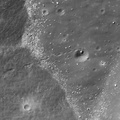
WIKIARCHIVES.SPACE
The Human Spaceflight Archive

A house-sized boulder (10 meter or 10 feet diameter) rolled down-hill, scoring a hole in one (~60 meter or ~66 yards diameter crater)! Portion of LROC NAC M122597190L, image width is 500 meters (547 yards) across.
Information
- Taken in
- Author
- NASA/GSFC/Arizona State University
- Description
-
A house-sized boulder (10 meter or 10 feet diameter) rolled down-hill, scoring a hole in one (~60 meter or ~66 yards diameter crater)! Portion of LROC NAC M122597190L, image width is 500 meters (547 yards) across.
NASA's Goddard Space Flight Center built and manages the mission for the Exploration Systems Mission Directorate at NASA Headquarters in Washington. The Lunar Reconnaissance Orbiter Camera was designed to acquire data for landing site certification and to conduct polar illumination studies and global mapping. Operated by Arizona State University, LROC consists of a pair of narrow-angle cameras (NAC) and a single wide-angle camera (WAC). The mission is expected to return over 70 terabytes of image data.
- Created on
- Thursday 20 May 2010
- Albums
- US SPACE PROGRAM / PROBES / MOON / LRO/LCROSS / Mission Photos (Edited)
- Source link
- https://photojournal.jpl.nasa.gov
- Visits
- 17
- Rating score
- no rate
- Rate this photo
- License
- Public Domain
- Modified by WikiArchives
- No (original)
- Downloads
- 0
Powered by Piwigo













































































































